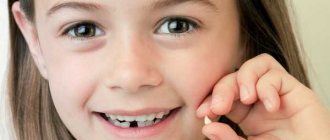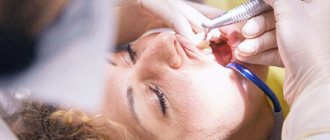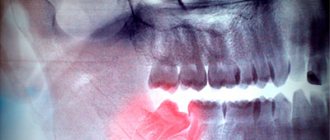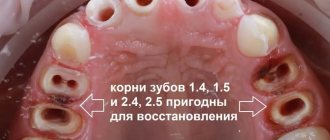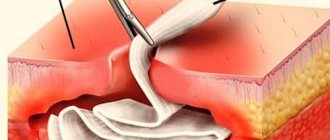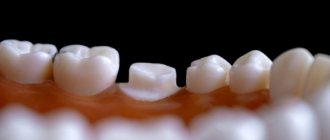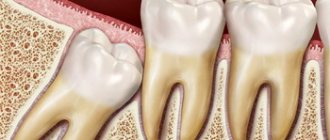Tooth extraction is one of the oldest procedures in dentistry. If previously it was practically impossible to pull out a tooth without blood and pain, today dental offices have all the necessary medications and instruments to make this procedure quick and painless for both children and adults.
You can pull out a tooth both in the clinic and at home, but it is important to understand that the procedure involves surgical intervention and is risky for those who do not have special knowledge. There are many indications for tooth extraction, but the main one is the replacement of baby teeth or a chronic infection that destroys the root and permanent tooth, and harms the entire oral cavity. Many patients come to us because of pain in the area of their wisdom teeth. In many cases they are also removed.
Content:
- Causes of the anomaly
- What does a “shark” smile lead to?
- When to see a doctor
- When to hesitate to see a doctor
- How is the treatment carried out?
The situation when a molar has erupted, but the milk tooth is in no hurry to leave its place, dentists call a “shark” bite. This is due to the fact that sharks also have units arranged in two rows. In humans, such an anomaly does not look aesthetically pleasing at all. Parents usually get very scared when they see a “double” smile on their child. Should I be concerned if a tooth comes out but the baby tooth does not fall out, and what could this lead to? Let's figure it out together.
Importance of baby teeth
By the age of three, all milk teeth have already erupted, and the process of resorption of their roots begins. Preparations for their replacement begin. The importance of baby teeth in the correct development of the bite and the eruption of permanent teeth is great. It is these temporary teeth that set the location and direction of growth for the molars that replace them.
As a result, premature loss of a temporary tooth causes irregular, chaotic growth of teeth and malocclusion. The consequence of this can lead to dental disorders. Thus, early removal of baby teeth should only be performed for very compelling reasons.
Causes of the anomaly
If the permanent tooth is erupting but the baby tooth has not fallen out, it can be assumed that the child is not eating enough solid food. With a deficiency of chewing load, the roots of temporary units are in no hurry to dissolve.
The diet of modern children is indeed too “gentle”, one might even say refined. It consists of products that have undergone step-by-step heat treatment. Chewing them requires almost no effort.
If parents think that children need to be given soft and thoroughly steamed food, then they are mistaken. To change teeth in a timely manner and form a correct bite, you need to eat a lot of fresh vegetables and fruits, and other foods that require careful chewing. Then the problem of preserving primary canines, incisors and molars for too long will not arise.
Another possible cause of the problem described is the presence of scars on the gums. If in the first years of life the baby has undergone dental surgery or received a serious injury, a burn to the oral cavity, scars may form on his gums. They consist of very dense connective tissue that prevents teeth from erupting.
Oral hygiene with a loose tooth
Prevention of childhood caries is so important that its importance cannot be overestimated. This applies not only to indigenous, but also to temporary units. The health of permanent incisors and molars depends on the condition of temporary chewing organs. Therefore, dentists recommend carefully treating the oral cavity of babies. By the age of two, you should visit the dentist for the first time for a preventive examination.
Children's crowns have soft, unformed tissue, so they are very sensitive and vulnerable. Care involves cleaning incisors and molars twice a day. When temporary units become loose and fall out, the gum tissue can become inflamed. Therefore, you need to use high-quality children's toothpaste to gently treat your mouth. Such products are suitable for thin enamel; they prevent caries and do not contain abrasives or fluoride.
Even with mobile units, hygiene procedures must be carried out twice a day to prevent the development of bacteria. Do not touch or pull the organ with dirty hands. If a baby brush does not remove food debris, it should be flossed. This procedure must be done by the mother. It is good if parents encourage their children to be responsible for cleaning their mouths.
What does a “shark” smile lead to?
Should you be scared if a new unit comes out, but the milk unit does not fall out? This situation should alert parents. Double dentition can lead to problems with articulation and diction. Then the child will have difficulties with the correct pronunciation of sounds and words.
Also, many patients with the described anomaly have difficulty eating food - they feel uncomfortable biting off hard foods, and when chewing them, small particles often get lodged under the gum. This means that the child will get used to swallowing poorly chewed food. This leads to disturbances in the functioning of the gastrointestinal tract, including flatulence and abdominal pain.
It happens that children who have double units in several places at once begin to lose weight. This is again due to improper chewing of food. During a meal, they swallow large pieces and because of this they swallow a lot of air. Therefore, they often have the illusion of satiety - a feeling of fullness when very little has been eaten.
Among the dental complications caused by untimely change of units:
- caries;
- inflammation of the gums;
- deposition of a large amount of soft plaque.
Therefore, you should not put off visiting the dentist. The doctor will conduct an examination and decide whether to remove the extra unit.
Surgical intervention
Comprehensive treatment of a loose tooth is effective in the early stages of the disease. If the loosening of the tooth progresses, then another treatment is prescribed.
Most often, this is a patchwork surgical operation, during which damaged areas of periodontal tissue, which are the source of inflammation, are removed. The operation is preceded by a splinting process. Through this process, the load on the teeth is redistributed.
Tooth extraction is the most extreme method of dealing with lesions that cause looseness. The reason for tooth extraction can be severe mechanical impact or serious injury, when tooth restoration is almost impossible. Our dentists will do everything possible to preserve your natural teeth. Surgical operations in our clinic if you have a loose tooth are kept to a minimum.
Source . The article was prepared based on materials provided by orthopedic dentist, surgeon, candidate of medical sciences Konstantin Anatolyevich Prokopyev. Doctor of the highest category, work experience in the specialty since 1994. In 2010 he defended his Ph.D. Combines practical work with management of a dental clinic.
When to see a doctor
Doctors believe that a “shark” smile can last up to two to three months, then it is necessary to take action. If the baby tooth does not fall out within the specified period, it needs to be removed. If you do not do this, the complications described above may occur.
But what’s even worse is that the child’s bite may be disrupted. The permanent unit will take the wrong position or be at the wrong angle. Then you will have to correct its position using plates or braces, and this is always difficult and time-consuming.
It is important to know! If a permanent tooth has come out, but the baby tooth has not yet fallen out, you can monitor the situation for several weeks. It is important to ensure that the child carefully maintains oral hygiene. If after two or three months nothing has changed, you need to make an appointment for your baby to see a dentist. But this recommendation is relevant only if the little patient is not bothered by anything and does not complain of toothache.
When is removal necessary?
There are relative and absolute indications. This, for example, is a highly carious lesion that leaves no chance of cure. Another reason is that the process of eruption of a permanent tooth has already begun when the milk tooth has not fallen out. Various diseases have absolute indications: fistulas on the gums, cysts on the roots, severe forms of pulpitis, periodontitis, etc.
Relative indications are the need to remove a loose tooth, which for some reason cannot fall out on its own, causes discomfort, and can cause inflammation of the gums.
When to hesitate to see a doctor
If a “shark” problem appears and the child complains of pain, the gums are inflamed, swollen, you need to immediately get dental care. Also warning symptoms are:
- bad breath;
- bleeding of the affected gums;
- separation of pus in the area of inflammation;
- severe discomfort while chewing food.
You should not wait a day if the child has a predisposition to malocclusion, for example, if he has previously undergone treatment for malocclusion or one of the parents wore braces. In all these situations, removal should be carried out as soon as possible. This measure will be a good prevention of possible complications.
What not to do for tooth loss
When a child complains of a loose tooth, parents should not use methods to remove it, based on funny videos from the Internet:
- Do not tie one end of the string to a tooth and the other to a door handle, bicycle, or anything else. This method will not work if the tooth is firmly seated, but will only bring pain and psychological trauma to the child. There is also a high probability of removing only part of the tooth, without the root;
- tweezers, clamps, rope, pliers and other tools are also not suitable for the procedure, since carelessness can injure and frighten the child;
- moving the tooth left and right - this injures the gums, causing bleeding and causing discomfort to the child.
Have you ever helped your child loosen a tooth? Or does he do it on his own? Share interesting stories in the comments.
Main photo: 1000sovetov.ru.
How is the treatment carried out?
When choosing treatment tactics, the dentist takes into account:
- how old is the patient;
- how long ago the permanent unit emerged;
- how much the molar crown appeared;
- what condition is the milk unit in;
- does the child have any complaints;
- general condition of the dentition;
- the patient has a predisposition to dental anomalies.
After conducting an in-person examination, the dentist decides whether to pull out the interfering tooth or leave it and wait until its roots resolve on their own. In the first case, local anesthesia is administered and removal is carried out; in the second, the doctor tells you when the baby needs to come for a second examination. Thus, if you deal with the problem of a “shark” smile in a timely manner, it will not cause negative consequences.
What treatment to choose if a tooth is loose
If you find that your tooth is loose, do not rush into thinking that you will have to remove it. Often, the problem of loose teeth can be solved by treating the oral disease that contributed to it. But only a dentist can prescribe this treatment.
If for some reason you cannot visit the dentist just yet, then remember a number of recommendations that will protect your teeth from even further loosening:
- Try not to eat fruits, which can have an additional harsh effect on the tooth and gums. Such foods include nuts, seeds, carrots, and apples. Be careful when eating other soft fruits and apples to avoid damaging your teeth from the pits.
- Do not eat food that is too hot or too cold, and do not allow sudden changes in temperature while eating. Limit your consumption of tea and coffee, as well as alcohol.
- You still need to brush your teeth twice a day - morning and evening, you can use mouth rinses. Choose a toothbrush that is not too hard and be careful with the damaged tooth when brushing. Use toothpaste that strengthens your gums.
There are also several traditional remedies that will keep your teeth safe before your appointment with the dentist. Mix honey with salt in the proportion of 5-10 grams of table salt (preferably burnt) per 20 grams of honey. Wrap the resulting pulp in a piece of cloth and rub it into the gums and tooth.
If a tooth is loose, a solution of alcoholic extract of propolis is also effective (a 10-15 percent solution is required). Add 20 drops to a glass of water and rinse your mouth. The solution also protects teeth from caries.
Preparing a child for tooth extraction
Before pulling out a child’s tooth, it is important to carry out psychological preparation - explain in a calm voice the essence of the procedure and its purpose, emphasizing that it is not painful and quick. You can come up with a fairytale story about the milkman's journey or tell that mom and dad also had their temporary teeth pulled out.
You also need to ask the child to swing the tooth as much as possible with his tongue - this will make it possible to quickly pull it out of the gums. When the milkman wobbles, its short nerve endings are torn off or pulled out of the canals, so there is no pain syndrome.
What to do after a blow
Dental bruises are closed injuries received after strong mechanical impact. (hitting a hard object). In this case, the teeth remain in place, do not move, but may begin to move. The front ones are especially vulnerable. If your front tooth becomes loose after an impact, you should immediately consult a doctor so that you can save it. X-rays and electroodontodiagnosis are prescribed. The latest diagnostic method makes it possible to see the beginning of the development of tissue necrosis and remove dying particles to prevent inflammation.
As a rule, medications are not used for tooth bruises. Swelling of the gums is relieved with cold compresses, and the patient must be on a liquid diet for some time to keep the molar at maximum rest. Sometimes, dentists practice grinding the cutting edge of the tooth and the cusps of the opposite tooth on the lower jaw, which the patient touches when chewing food.
Part of the molar is movable
Teeth can become loose and fall out in parts. When half a tooth is loose, the dentist takes an x-ray to determine whether the root is affected or only the outer part of the crown is damaged. If the root is not damaged and the base is preserved, then it can be saved. The upper part of the crown is removed and a pin is installed in its place. Then extension is carried out. If the pin cannot be placed, then a polymer filling is placed, and a crown is placed on it. When a tooth becomes very loose and the root is crushed, it is removed and an artificial crown is placed in its place.
How to pull a tooth at home without pain
Proper preparation should be made before beginning the removal procedure. Let's look at the important preparatory steps before this procedure:
- Assess your capabilities . Proceed with the procedure only if you are confident in your abilities. If in doubt, consult a doctor. This also applies to the child. If he has a strong fear of this procedure, then it is better to take him to the doctor.
- Examine the oral cavity . Carefully examine the oral cavity for swelling, redness, as well as carious lesions and other dental diseases. If you find any, consult a doctor and do not do anything on your own.
- Check tooth mobility . Be sure to check how flexible the tooth is. If the amplitude of loosening is insignificant, then postpone the procedure until later. We remind you once again that the tooth should wobble as if it were being held on by a string.
- Prepare your tools . Later we will talk about how you can pull out a tooth at home, and what tools and things you will need for this. Prepare them in advance so that the necessary items are on hand. Prepare a small container for your child to spit into during (or after) the procedure. You should also have an antiseptic on hand.
- Have a conversation with your child . Talk to your child about this first. Tell him that the procedure is painless, so there is nothing to be afraid of. Remember that if the child twitches or acts up during the procedure, there is a high risk of incorrect tooth extraction.
- Feed the baby . After removal, it is not recommended to eat for 2-3 hours. Therefore, it is advisable to feed the child before the removal procedure.
Now let’s look at five ways to pull out a child’s loose tooth.
Method No. 1 - gradual loosening
This is the simplest and most effective way that the child himself can cope with. You don't need any improvised means for this. Gradually loosen the tooth until it falls out.
In this case, it is important to ensure that the child’s hands are clean. So before you start loosening, wash your hands with soap and water.
Method number 2 - solid food to help
Another simple way to quickly pull out a tooth at home without pain. Give your child solid food - juicy apples, dried apples or crackers. Within the first minutes, the child will feel the tooth falling out. The important thing here is not to swallow it.
Method number 3 - removal with thread
An old-fashioned method that has not lost popularity to this day. Wrap the loose tooth with floss and tie the other end to the doorknob. Then sharply pull the door, after which it will “fly out”.
If pulling a tooth with a doorknob sounds archaic to you, you can do this procedure without a door. To do this, simply pull the thread sharply. The important thing here is to pull the thread upward. If you pull to the side, you risk damaging your gums.
Method No. 4 - removal using medical gauze
Pre-moisten the gauze in an antiseptic solution. Then grab the tooth with gauze and slowly rock it. If you see that the tooth is loosening well, then it is better to pull it out in one sharp movement. In this case, removal will be painless.
Method No. 5 – tooth extraction at the dentist
The surest way not to harm your child is to see a dentist. The doctor will examine the oral cavity and take into account all the circumstances. This is the most reliable way from the point of view of the child’s health.
Visiting the dentist
After a complete examination of the oral cavity, the doctor will be able to determine the true cause of tooth loss, prescribe a treatment plan, and restore lost teeth. As a rule, patients undergo dental prosthetics in Minsk or dental implantation. Minsk Family Dentistry Center offers dental treatment and restoration services without pain and discomfort. "It happens?" - you ask. Of course, if you use drug sedation. In essence, treatment under sedation is high-quality dental treatment while you sleep , while the patient is relaxed and calm. The pain threshold increases significantly, and salivation decreases - this allows all operations to be carried out quickly and efficiently, which is especially important in pediatric dentistry.
Installing implants and dentures will restore beauty to your smile and health and strength to your teeth. In addition, you can choose the most natural designs that are practically no different from real teeth. Modern dentistry allows everyone to achieve an ideal smile, the main thing is desire and a responsible approach. Among the variety of methods of treatment and restoration of dentition, everyone can find something of their own, both in terms of appearance and price.
